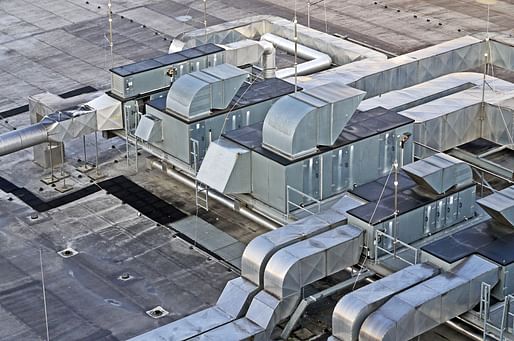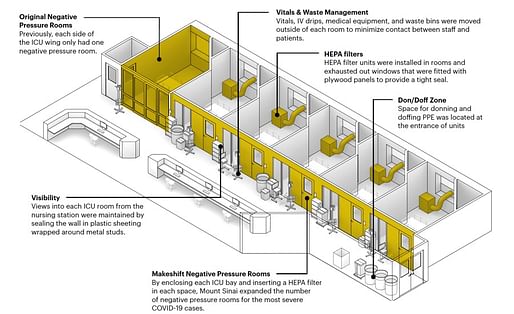

As society plans its transition out of the first phase of the COVID-19 pandemic response and into a new era of social distanced, post-quarantine life, the gradual re-inhabitation of existing buildings will necessitate that many aspects of daily life be re-examined, both in terms of social custom and functional layout.
Lecture halls and performance spaces that once held hundreds will now accommodate dozens; High-rise office buildings will see their capacities drastically reduced, as well; Grocery aisles will be redesigned to allow for more space between shoppers; Restaurants could see their dining rooms transported outdoors; Banks, post offices, government buildings, and all sorts of commercial, cultural, and entertainment facilities will likely, either periodically or for a period of time moving forward, will be impacted by this shift.

These changes will be put into motion because the virus spreads not just through the surfaces we touch, but also through the air we breathe. Researchers estimate that the average sneeze, for example, creates virus-containing droplets that travel at least two meters from the source. Some researchers estimate that those distances are actually much higher, especially for smaller particles like viruses. Either way, these tiny droplets land on surfaces, where they can be sanitized away, yes, but they also, in large part, stay airborne and can find themselves transported to other surfaces, or are aspired directly into our lungs. And while many high-traffic tactile areas, including doorways, payment terminals, and elevators, might become touchfree or reconfigured in different materials or designs to help limit the spread of future disease through their surfaces, the way the air we breathe inside of buildings is handled, circulated, and refreshed is also likely to change fundamentally.
That is in large part due to the fact that many HVAC systems, whether in office buildings, shopping malls, or airplanes, make use of recycled air.
From a heating and cooling perspective, recirculating air makes a lot of sense. As fresh ambient air is brought into the building, it is also heated or cooled to a specified temperature, thus requiring a certain expenditure of energy. In order to reduce the amount of energy consumed by HVAC systems, air that has already been conditioned to the right temperature is, in large part, recirculated throughout the building, augmented with a certain percentage of fresh air. Typically, for offices, classrooms, retail areas, and other commonly used spaces people frequent throughout their daily lives, conditioned air breathed indoors includes between 15% and 20% fresh air, meaning that at least 80% of that air is, in a post-COVID world, potentially contaminated.
In response to this issue, some in the HVAC industry have begun to advocate for what is called “hygiene ventilation,” a building ventilation approach that uses 100% fresh air to help ensure that viruses are not spread through mechanical ventilation systems but are instead pushed out of the building continuously.
In the recent April 2020 edition of the CIBSE Journal, for example, the Federation of European Heating, Ventilation, and Air Conditioning Associations (REHVA) issues interim guidance for COVID-19 adaptation of existing buildings that calls for “avoiding central recirculation during [COVID-19] episodes and closing the recirculation dampers, even if there are return air filters” during future outbreaks. “Virus particles in return ducts can re-enter a building if centralized air handling units have recirculation,” the article states.
To eliminate the potential of pathogen spread through recirculated air, the organization writes, “The general advice is to supply as much outside air as possible. Expanded operation times are recommended for buildings with mechanical ventilation. Consider keeping the ventilation on 24/7 with lower ventilation rates when people are absent.”
For businesses that are reoccupying their workspaces, the group advises that “if employee numbers reduce, do not place remaining staff in smaller areas,” but to instead give more space to fewer people.
The report also indicates that bathrooms are an under-protected source of pathogen spread in buildings, as virus-containing droplets can emanate from toilet water and drainage areas into the general air supply via exhaust fans, or if microbes residing in those areas are propelled into the air by changes in building pressurization. “Exhaust ventilation systems of toilets should always be left on 24/7, and relatively negative pressure must be maintained in the room air to help avoid faecal-oral transmission,” the group writes.
The group’s interim guidance advises building operators to “use more window-driven natural ventilation,” in addition to supplying copious amounts of fresh air.
Together, these requirements have vast implications for how we use everyday spaces, not least of which surrounding the topic of energy consumption of existing buildings. As stated earlier, the main reason conditioned air is recirculated in the first place is to minimize energy consumption. Simply put, delivering 100% fresh air in conditioned indoor settings is extremely energy intensive, especially in older, poorly insulated, and leaky buildings that have not been brought up to the strictest energy performance standards. Paradoxically, these impacts are also amplified for new energy efficient buildings that utilize exhaust air for “heat recovery ventilation” to minimize energy consumption by using exhaust air to temper incoming air through indirect energy transfer. Under current guidance from REHVA, as a recent report from Bere Architects in the UK states, “until the virus is completely stamped out, world-wide energy use due to buildings is set to climb steeply if air-recirculation is not allowed in conventional buildings.”
The firm’s research suggests that the “Hygiene Ventilation” approach is only really feasible from an energy perspective for Passive House buildings, while conventional buildings might require up to six times the amount of energy to maintain 100% fresh air circulation.
Meanwhile, a recent United Nations report remarks that “cooling is now responsible for about 10% of global warming and growing rapidly,” setting up a dire trajectory for buildings globally in this new era.
This situation creates the necessity, as Billy Fleming and Alexandra Lillehei of the University of Pennsylvania Weitzman School of Design’s McHarg Center write in a recent Jacobin article, to enact a wide-ranging “green stimulus” that focuses on “deep energy retrofits alongside much-needed abatement work in buildings, public schools, libraries, and other civic infrastructure,” work that architects can undertake as part of government-led efforts to recover economically from the COVID-19 crisis. This work, as Fleming and Lillehei argue in their article, offers a “generational opportunity to remake an economic system that is already being restructured by COVID-19,” a statement that also applies to not just the economy but also buildings and the built environment itself.
This vision entails applying the expertise of architects toward not just designing and building new energy-efficient and hygienic buildings, but also, and perhaps more importantly, toward updating our existing building stock. According to the Center for Sustainable Systems at the University of Michigan, over 70% of commercial buildings in the US are over 20 years old, meaning that a sizable majority of the structures we use daily are likely inefficient and due for energy upgrades anyway, and that’s on top of myriad other problems that have also yet to be addressed, like universal accessibility, lead paint and asbestos abatement, and now, ventilation strategies.
Though the goals of recovering from COVID-19 and addressing runaway carbon emissions might seem like two separate issues, it’s becoming increasingly clear that they are in fact deeply linked in more ways than one. “We must imagine a Green Stimulus as a down payment on a more just economy, on building a shorter path to net-zero emissions,” Fleming and Lillehei explain, articulating positions that have been taken, in parts, by a variety of design organizations, including the American Institute of Architects and The Architecture Lobby.
The question now is whether architects can come together and muster the political will--and power--to move beyond advocacy and toward the implementation of the types of necessary investments and structural changes that can help firms and employees bounce back from the COVID-19 crisis in a way that lends new significance and purpose to their work. Will that happen?
No Comments
Block this user
Are you sure you want to block this user and hide all related comments throughout the site?
Archinect
This is your first comment on Archinect. Your comment will be visible once approved.